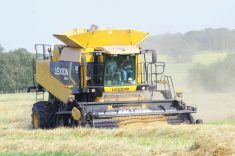Glacier FarmMedia—Planting across Manitoba progressed during the week ended June 16 despite cool, wet and windy weather, including small tornadoes.
Seeding advanced five points to 97 per cent, compared to the five-year average of 100 per cent, according to the province’s weekly crop report released on June 18. Corn and field pea planting were 100 per cent complete, while spring wheat seeding was at 99 per cent complete. Barley and oats were at 98 per cent, soybeans were at 97 per cent and canola was at 96 per cent.
Read Also

India slaps 30 per cent import duty on yellow peas
India has imposed a 30 per cent duty on yellow pea imports with a bill of lading date on or after Nov. 1, 2025.
Additional acres were being planted in areas with excess moisture with some re-seeding occurring. Herbicide applications were ongoing and insecticide was needed to hold off flea beetles. Hail and strong winds caused some crop damage in some areas.
Winter wheat development was from boot stage to full head emergence, while fall rye was from full head emergence and flowering to beginning of seed fill. Spring cereals ranged from three to five-leaf stage and tillering to flag leaf, while corn ranged from V2 to V6.
The earliest grown canola has started bolting, but some re-seeding was required due to flea beetle damage. Sunflowers were in growth stages V3 and V4, while the most advanced flax was in growth stage four, the start of leaf spiral.
Most field peas were in the six to eight node stages. The most advanced soybeans were in the second trifoliate stage, while dry beans were in the first.
Good moisture has allowed hay and pasture fields to grow rapidly, but would benefit more from warmer weather. Bromes and ryegrasses were tillering to heading, while alfalfa was in late bud to mid-flower. Alfalfa stands were 20 to 24 inches tall in the southwest region and up to 28 inches in the central region along with tame hay. Some farms have finished first cut of alfalfa for silage, with initial yields in eastern Manitoba below average due to overwintering damage and cooler spring temperatures. Leaf hoppers started to appear in fields in the southwest.
Most cattle were on pasture and breeding season has begun on some farms. While dugouts were full, producers were trying to limit fly numbers and were looking for pink eye and foot rot.
Tornadoes touched down in western Manitoba near Rivers, Baldur and Swan Lake First Nation on June 12 with winds up to 113 kilometres per hour recorded. Fork River in the northwest region received the most precipitation during the week at 54.8 millimetres, while the driest was Gardenton in eastern Manitoba at 7.8 mm.
Most areas have exceeded 150 per cent of normal precipitation during this growing season with the central region receiving the most. The two wettest locations in Manitoba this season were Winkler (216 mm, 208 per cent normal precipitation) and Eden (208 mm, 216 per cent). The three driest were Moosehorn (96 mm, 105 per cent), Deloraine (97 mm, 108 per cent) and Elma (114 mm, 105 per cent).












